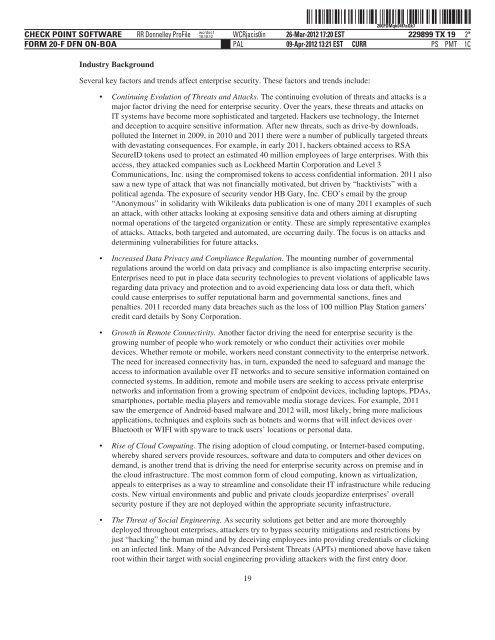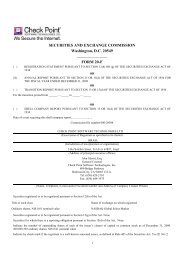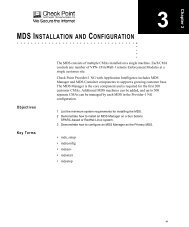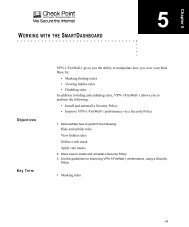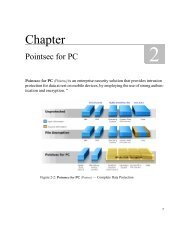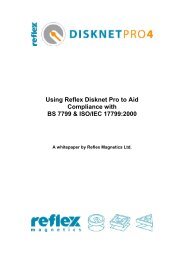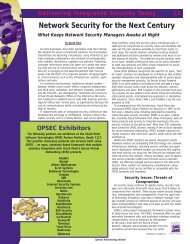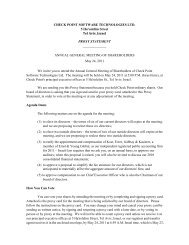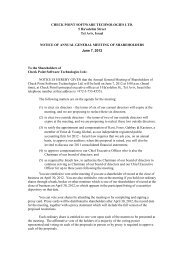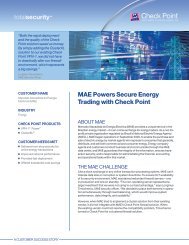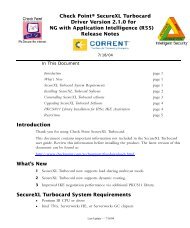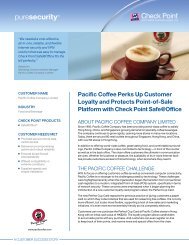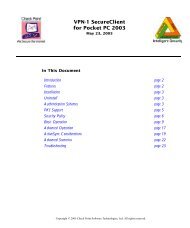printmgr file
printmgr file
printmgr file
Create successful ePaper yourself
Turn your PDF publications into a flip-book with our unique Google optimized e-Paper software.
CHECK POINT SOFTWARE<br />
FORM 20-F DFN ON-BOA<br />
Industry Background<br />
ˆ200FDMqk04f7aQk7†Š<br />
200FDMqk04f7aQk7<br />
RR Donnelley ProFile wcrdoc1<br />
10.10.12 WCRjacis0in 26-Mar-2012 17:20 EST<br />
229899 TX 19 2*<br />
PAL<br />
09-Apr-2012 13:21 EST CURR<br />
PS PMT 1C<br />
Several key factors and trends affect enterprise security. These factors and trends include:<br />
• Continuing Evolution of Threats and Attacks. The continuing evolution of threats and attacks is a<br />
major factor driving the need for enterprise security. Over the years, these threats and attacks on<br />
IT systems have become more sophisticated and targeted. Hackers use technology, the Internet<br />
and deception to acquire sensitive information. After new threats, such as drive-by downloads,<br />
polluted the Internet in 2009, in 2010 and 2011 there were a number of publically targeted threats<br />
with devastating consequences. For example, in early 2011, hackers obtained access to RSA<br />
SecureID tokens used to protect an estimated 40 million employees of large enterprises. With this<br />
access, they attacked companies such as Lockheed Martin Corporation and Level 3<br />
Communications, Inc. using the compromised tokens to access confidential information. 2011 also<br />
saw a new type of attack that was not financially motivated, but driven by “hacktivists” with a<br />
political agenda. The exposure of security vendor HB Gary, Inc. CEO’s email by the group<br />
“Anonymous” in solidarity with Wikileaks data publication is one of many 2011 examples of such<br />
an attack, with other attacks looking at exposing sensitive data and others aiming at disrupting<br />
normal operations of the targeted organization or entity. These are simply representative examples<br />
of attacks. Attacks, both targeted and automated, are occurring daily. The focus is on attacks and<br />
determining vulnerabilities for future attacks.<br />
• Increased Data Privacy and Compliance Regulation. The mounting number of governmental<br />
regulations around the world on data privacy and compliance is also impacting enterprise security.<br />
Enterprises need to put in place data security technologies to prevent violations of applicable laws<br />
regarding data privacy and protection and to avoid experiencing data loss or data theft, which<br />
could cause enterprises to suffer reputational harm and governmental sanctions, fines and<br />
penalties. 2011 recorded many data breaches such as the loss of 100 million Play Station gamers’<br />
credit card details by Sony Corporation.<br />
• Growth in Remote Connectivity. Another factor driving the need for enterprise security is the<br />
growing number of people who work remotely or who conduct their activities over mobile<br />
devices. Whether remote or mobile, workers need constant connectivity to the enterprise network.<br />
The need for increased connectivity has, in turn, expanded the need to safeguard and manage the<br />
access to information available over IT networks and to secure sensitive information contained on<br />
connected systems. In addition, remote and mobile users are seeking to access private enterprise<br />
networks and information from a growing spectrum of endpoint devices, including laptops, PDAs,<br />
smartphones, portable media players and removable media storage devices. For example, 2011<br />
saw the emergence of Android-based malware and 2012 will, most likely, bring more malicious<br />
applications, techniques and exploits such as botnets and worms that will infect devices over<br />
Bluetooth or WIFI with spyware to track users’ locations or personal data.<br />
• Rise of Cloud Computing. The rising adoption of cloud computing, or Internet-based computing,<br />
whereby shared servers provide resources, software and data to computers and other devices on<br />
demand, is another trend that is driving the need for enterprise security across on premise and in<br />
the cloud infrastructure. The most common form of cloud computing, known as virtualization,<br />
appeals to enterprises as a way to streamline and consolidate their IT infrastructure while reducing<br />
costs. New virtual environments and public and private clouds jeopardize enterprises’ overall<br />
security posture if they are not deployed within the appropriate security infrastructure.<br />
• The Threat of Social Engineering. As security solutions get better and are more thoroughly<br />
deployed throughout enterprises, attackers try to bypass security mitigations and restrictions by<br />
just “hacking” the human mind and by deceiving employees into providing credentials or clicking<br />
on an infected link. Many of the Advanced Persistent Threats (APTs) mentioned above have taken<br />
root within their target with social engineering providing attackers with the first entry door.<br />
19


